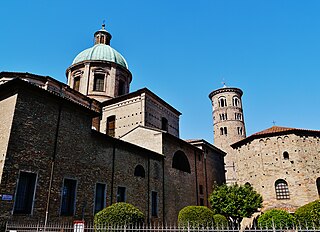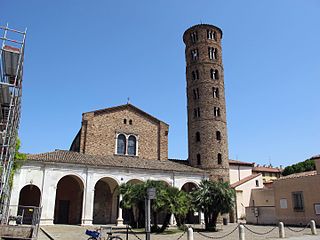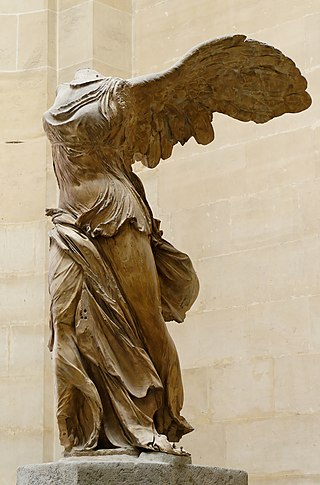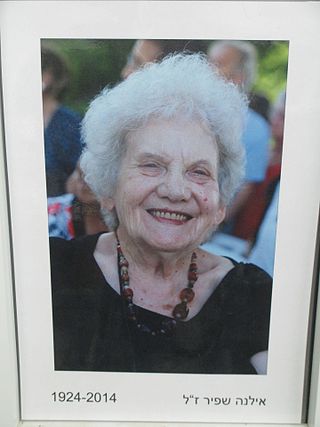
Ravenna is the capital city of the Province of Ravenna, in the Emilia-Romagna region of Northern Italy. It was the capital city of the Western Roman Empire during the 5th century until its collapse in 476, after which it served as the capital of the Ostrogothic Kingdom and then the Byzantine Exarchate of Ravenna.

A mosaic is a pattern or image made of small regular or irregular pieces of colored stone, glass or ceramic, held in place by plaster/mortar, and covering a surface. Mosaics are often used as floor and wall decoration, and were particularly popular in the Ancient Roman world.

In European academic traditions, fine art is made primarily for aesthetics or creative expression, distinguishing it from decorative art or applied art, which also has to serve some practical function, such as pottery or most metalwork. In the aesthetic theories developed in the Italian Renaissance, the highest art was that which allowed the full expression and display of the artist's imagination, unrestricted by any of the practical considerations involved in, say, making and decorating a teapot. It was also considered important that making the artwork did not involve dividing the work between different individuals with specialized skills, as might be necessary with a piece of furniture, for example. Even within the fine arts, there was a hierarchy of genres based on the amount of creative imagination required, with history painting placed higher than still life.

The Basilica of Sant'Apollinare Nuovo is a basilica church in Ravenna, Italy. It was erected by the Ostrogothic king Theodoric the Great as his palace chapel during the first quarter of the 6th century. This Arian church was originally dedicated in 504 AD to "Christ the Redeemer".

The Arian Baptistry in Ravenna, Italy is a Christian baptismal building that was erected by the Ostrogothic King Theodoric the Great between the end of the 5th century and the beginning of the 6th century A.D., at the same time as the Basilica of Sant' Apollinare Nuovo.

Hellenistic art is the art of the Hellenistic period generally taken to begin with the death of Alexander the Great in 323 BC and end with the conquest of the Greek world by the Romans, a process well underway by 146 BC, when the Greek mainland was taken, and essentially ending in 30 BC with the conquest of Ptolemaic Egypt following the Battle of Actium. A number of the best-known works of Greek sculpture belong to this period, including Laocoön and His Sons, Venus de Milo, and the Winged Victory of Samothrace. It follows the period of Classical Greek art, while the succeeding Greco-Roman art was very largely a continuation of Hellenistic trends.

The Gladiator Mosaic is a famous set of 5 large mosaics of gladiators and venators and two smaller ones. The mosaics are dated to the first half of the 4th century and are now installed in the Salone of the Galleria Borghese in Rome. They were discovered in 1834 on the Borghese estate at Torrenova, on the Via Casilina outside Rome. Prince Francesco Borghese Aldobrandini requested the excavations be completed. It is believed to have decorated a cryptoporticus of an inner peristylum for a large domus. The mosaics were removed from excavations and restored by Gaetano Ruspi and Filippo Scaccia in 1839. These panels reinvigorated the Borghese Collection after it had shrunk following the sale of much of the collection to Napoleon I.

Pauly & C. - Compagnia Venezia Murano is one of the oldest glass factories of Murano: it was founded more than 150 years ago. The company produces glass art, most notably Roman murrine, mosaics and chandeliers.

Marcelo José de Melo is a Brazilian artist. He was born in Apucarana, Paraná, and lives and works in Amsterdam, the Netherlands..
Elaine M. Goodwin is a British artist and author. She has exhibited extensively, written several works on art and design, and was founder president of the British Association of Modern Mosaics (BAMM). Together with other prominent artists, Goodwin also co-founded Tessellated Expression for the 21st Century (TE-21), a group of professional artists dedicated to exhibitions of the tessellated art form.

The Zliten mosaic is a Roman floor mosaic from about the 2nd century AD, found in the town of Zliten in Libya, on the east coast of Leptis Magna. The mosaic was discovered by the Italian archaeologist Salvatore Aurigemma in 1913 and is now on display at The Archaeological Museum of Tripoli. It depicts gladiatorial contests, animal hunts, and scenes from everyday life.
Andrea Cagnetti, also known as Akelo, is an Italian goldsmith, designer, and sculptor. He is known for his use of ancient techniques used in metalworking.
Eugen Ciucă was a Romanian-American artist known for his monumental sculptures, vivid paintings and drawings of delicate feminine figures. He spent the most successful years of his career in Italy, where he created many works inspired by the Divine Comedy and its author Dante Alighieri. Ciucă's art has been displayed in nearly 100 exhibitions across Europe and the United States.

The Sutton Heritage Mosaic is a large mural in the form of a mosaic situated in Sutton High Street in the town of Sutton in Greater London, England. One of the largest examples of wall art in Britain, it was commissioned by the London Borough of Sutton to celebrate the borough's heritage.

The Chicago Mosaic School is a 501c(3) non-profit organization dedicated to advancing the fine art of mosaic and providing opportunities for comprehensive study with an academic, materially-oriented approach to art education. Since it was founded in 2005 by artist Karen Ami, the school remains one of the only mosaic fine arts schools outside of Europe, with classrooms, the Gallery of Contemporary Mosaics (GoCM), private artist studios and the CMS shoppe. The faculty is made up of a permanent teaching staff, as well as a visiting collection of international contemporary mosaic artists. The school has increased an awareness and appreciation for this ancient art form, and has created an open community for learning, sharing expertise, and developing the medium within the contemporary context. The Chicago Mosaic school is located in Chicago’s Edgewater neighborhood on Granville Avenue.

Byzantine mosaics are mosaics produced from the 4th to 15th centuries in and under the influence of the Byzantine Empire. Mosaics were some of the most popular and historically significant art forms produced in the empire, and they are still studied extensively by art historians. Although Byzantine mosaics evolved out of earlier Hellenistic and Roman practices and styles, craftspeople within the Byzantine Empire made important technical advances and developed mosaic art into a unique and powerful form of personal and religious expression that exerted significant influence on Islamic art produced in Umayyad and Abbasid Caliphates and the Ottoman Empire.
Lilian Broca is a Canadian artist and art educator based in Vancouver, British Columbia.

Gary Drostle is a British artist specialising in public art, sculpture and mosaic as well as mural painting and drawing. He was also President of the British Association for Modern Mosaic, a lecturer at The Chicago Mosaic School. and is on the editorial board of Andamento the Journal of Contemporary Mosaics.
Arounna Khounnoraj is a Canadian multi-disciplinary artist, teacher and author.

Ilana Shafir was an Israeli mosaic artist, globally known for her unique style spontaneous mosaic, a technique in which the artistic work emerges without prior painting unlike the traditional mosaic work. Since the 1960s, she fashioned “extraordinary works mixing figurative and abstract motifs” in her studio in Ashkelon.














